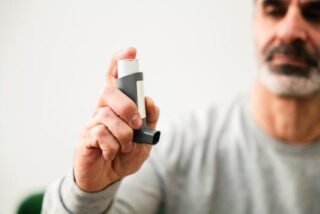
More Chronic Illness Articles
Is It COPD? A Simple Guide to Self-Testing Your Lung Health

Chronic Obstructive Pulmonary Disease (COPD) is a common respiratory condition that can significantly impact your daily life. If you’re concerned about your lung health and wonder how to test yourself for COPD, this guide can help. While professional diagnosis is crucial, understanding preliminary steps can be beneficial and provide insights into when to seek medical advice.
How to Test Yourself for COPD
Though self-testing for COPD doesn’t replace professional evaluation, certain methods can help you assess your lung function. These methods focus on assessing symptoms, monitoring changes in breathing, and recognizing risk factors. Let’s explore some of these simple steps.
Recognizing Symptoms
One of the first steps in self-testing is being aware of COPD symptoms. Common indicators include persistent coughing, increased mucus production, shortness of breath, particularly during physical activity, and frequent respiratory infections. If you regularly experience these symptoms, consider discussing them with your healthcare provider.
Online Assessment Tools
Several online platforms offer questionnaires to help evaluate your risk for COPD. These tools typically ask about smoking history, exposure to lung irritants, and symptom frequency. Although not diagnostic, they can provide a preliminary risk assessment. Be sure to use reputable sources recommended by health organizations.
Spirometry Kits
Home spirometry tests are devices that measure lung function by assessing how much and how quickly you can exhale air. While professional spirometry tests conducted by a healthcare provider are more accurate, these home kits can help monitor changes in lung health over time. Follow the instructions carefully and consider consulting your doctor for accuracy validation.
Lifestyle Considerations
Risk factors such as smoking, exposure to pollutants, and genetic predispositions play a significant role in developing COPD. If you have a history of smoking or work in environments with high exposure to pollutants, taking preventive actions is crucial. Triggers can be managed with lifestyle changes, which you can learn more about here.
Keeping a Symptom Diary
Documenting your symptoms is a simple yet effective way to track their frequency and severity. Keeping a daily log of symptoms like breathlessness, cough intensity, and mucus production can help identify patterns. This information can be valuable during medical consultations.
Professional Diagnosis for COPD
While these self-testing methods can indicate potential concerns, a formal diagnosis by a healthcare professional is essential. Doctors commonly use tests such as spirometry, imaging, and arterial blood gas analysis to confirm COPD. For more detailed information on testing and treatment, you can visit reliable sources like Wikipedia’s health page.
Consulting a Healthcare Provider
If your self-assessment suggests a high likelihood of COPD, or if you’re experiencing worsening symptoms, it’s vital to seek professional medical advice. Medical experts can offer precise tests and treatments tailored to your specific needs, ultimately improving your quality of life.
Conclusion
Understanding how to test yourself for COPD involves recognizing symptoms, utilizing home tests, and assessing risk factors. While these measures can provide initial insights, they shouldn’t replace professional medical assessments. Prioritizing lung health and knowing when to seek help is crucial for effective management and treatment of COPD.
- Self-testing for COPD includes symptom recognition and home spirometry.
- Professional evaluation is essential for an accurate diagnosis.
- Lifestyle changes significantly influence COPD risk and management.
- Online tools can provide a preliminary COPD risk assessment.
- Consult healthcare providers for personalized advice and treatment.
What are the common symptoms of COPD?
Common symptoms include chronic cough, shortness of breath, wheezing, and frequent respiratory infections. Persistent experience of these symptoms warrants a medical evaluation.
Can you diagnose COPD at home?
While certain tools can help assess your lung function, an official diagnosis requires professional testing by a healthcare provider.
What lifestyle changes can help manage COPD?
Quitting smoking, avoiding polluted environments, regular exercise, and maintaining a healthy diet can all contribute to better managing COPD.
Is it possible to reverse COPD?
Currently, there is no cure for COPD, but treatments and lifestyle modifications can help manage symptoms and slow disease progression.
How reliable are home spirometry tests?
Home spirometry tests can be helpful for monitoring, but their results should be validated with professional tests conducted by a healthcare provider for accuracy.
Other Articles You May Find of Interest...
- Exploring the Fascinating World of Synesthesia
- Understanding Raynaud’s: Causes, Symptoms, and Management Tips
- The Truth Behind Parkinson’s: It’s More Than Just Bad Luck
- Effective Management of Gout Symptoms with Allopurinol
- Is Your RDW Blood Test High? Understanding Its Impact on Your Health
- Empower Your Health: Essential Self-Care Strategies for Postural Orthostatic Tachycardia Syndrome
- Understanding Lymphedema Treatment: A Guide to Products and Solutions














